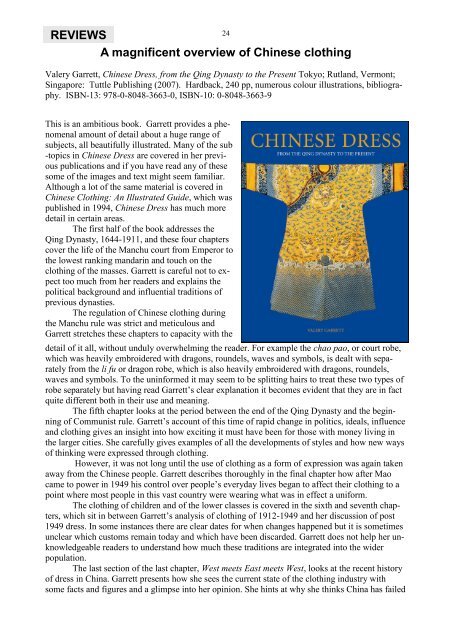Download - OATG. Oxford Asian Textile Group
Download - OATG. Oxford Asian Textile Group
Download - OATG. Oxford Asian Textile Group
Create successful ePaper yourself
Turn your PDF publications into a flip-book with our unique Google optimized e-Paper software.
REVIEWS<br />
24<br />
A magnificent overview of Chinese clothing<br />
Valery Garrett, Chinese Dress, from the Qing Dynasty to the Present Tokyo; Rutland, Vermont;<br />
Singapore: Tuttle Publishing (2007). Hardback, 240 pp, numerous colour illustrations, bibliography.<br />
ISBN-13: 978-0-8048-3663-0, ISBN-10: 0-8048-3663-9<br />
This is an ambitious book. Garrett provides a phenomenal<br />
amount of detail about a huge range of<br />
subjects, all beautifully illustrated. Many of the sub<br />
-topics in Chinese Dress are covered in her previous<br />
publications and if you have read any of these<br />
some of the images and text might seem familiar.<br />
Although a lot of the same material is covered in<br />
Chinese Clothing: An Illustrated Guide, which was<br />
published in 1994, Chinese Dress has much more<br />
detail in certain areas.<br />
The first half of the book addresses the<br />
Qing Dynasty, 1644-1911, and these four chapters<br />
cover the life of the Manchu court from Emperor to<br />
the lowest ranking mandarin and touch on the<br />
clothing of the masses. Garrett is careful not to expect<br />
too much from her readers and explains the<br />
political background and influential traditions of<br />
previous dynasties.<br />
The regulation of Chinese clothing during<br />
the Manchu rule was strict and meticulous and<br />
Garrett stretches these chapters to capacity with the<br />
detail of it all, without unduly overwhelming the reader. For example the chao pao, or court robe,<br />
which was heavily embroidered with dragons, roundels, waves and symbols, is dealt with separately<br />
from the li fu or dragon robe, which is also heavily embroidered with dragons, roundels,<br />
waves and symbols. To the uninformed it may seem to be splitting hairs to treat these two types of<br />
robe separately but having read Garrett‘s clear explanation it becomes evident that they are in fact<br />
quite different both in their use and meaning.<br />
The fifth chapter looks at the period between the end of the Qing Dynasty and the beginning<br />
of Communist rule. Garrett‘s account of this time of rapid change in politics, ideals, influence<br />
and clothing gives an insight into how exciting it must have been for those with money living in<br />
the larger cities. She carefully gives examples of all the developments of styles and how new ways<br />
of thinking were expressed through clothing.<br />
However, it was not long until the use of clothing as a form of expression was again taken<br />
away from the Chinese people. Garrett describes thoroughly in the final chapter how after Mao<br />
came to power in 1949 his control over people‘s everyday lives began to affect their clothing to a<br />
point where most people in this vast country were wearing what was in effect a uniform.<br />
The clothing of children and of the lower classes is covered in the sixth and seventh chapters,<br />
which sit in between Garrett‘s analysis of clothing of 1912-1949 and her discussion of post<br />
1949 dress. In some instances there are clear dates for when changes happened but it is sometimes<br />
unclear which customs remain today and which have been discarded. Garrett does not help her unknowledgeable<br />
readers to understand how much these traditions are integrated into the wider<br />
population.<br />
The last section of the last chapter, West meets East meets West, looks at the recent history<br />
of dress in China. Garrett presents how she sees the current state of the clothing industry with<br />
some facts and figures and a glimpse into her opinion. She hints at why she thinks China has failed

















